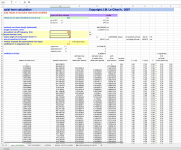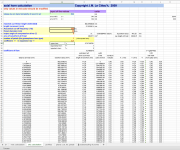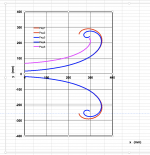I have some spreadsheets from him for his elliptical horns from about 6 years ago. I can try to find those and post them.
That would be great.
Anyone can calculate LeCleach Iwata horns?
Here are Jean-Michel Le Cléac'h's elliptical design spreadsheets. There is an explanation text file in the directory with the spreadsheets he sent me. The larger ones are zipped. If there are any issues with getting the files, let me know. These include his quasi elliptical, Iwata, and controlled horizontal directivity designs. Note that I have not used these spreadsheets yet, so I have no experience with them. If you build one of these, please post pictures to this thread. Also, please do not repost this link elsewhere.
Index of /JMLC_elliptical
Index of /JMLC_elliptical
Thanks for the JMLC420 you made up for me in oak.
Anyone who wants whatever type of horn CNC turmed from their own choice of wood they want, he will advise you and make them up for a reasonable price.
He shows some nice examples on his website.
Hi!
Maybe someone know throat angle of JMLC 1400 and 1500?
Best is to remove the throat adapter on the conpression driver if possible. Recommended by JMLC himself, regarding the JA-6681B.
Best is to remove the throat adapter on the conpression driver if possible. Recommended by JMLC himself, regarding the JA-6681B.
I know exit angle of CD (nd1070). I'm don't know throat angle of Auto-Tech JMLC1400 horn.
I have found the spreadsheet. But it has Old_calculation and New_calculation
The trick is that the new_calculation is dated 2007 and the old one -2009
Here are the pictures.
Does anybody know where is the new one or the right one?
The trick is that the new_calculation is dated 2007 and the old one -2009
Here are the pictures.
Does anybody know where is the new one or the right one?
Attachments
For Accuracy ...
... simply use David's Horn Response program,
Hornresp
and compare the results.
N.B., at the points of departure, it is not going to make any acoustical difference.
For a high frequency horn, use an OS horn body and finish it off with a mouth profile using JMLC or similar method.
WHG
I have found the spreadsheet. But it has Old_calculation and New_calculation
The trick is that the new_calculation is dated 2007 and the old one -2009
Here are the pictures.
Does anybody know where is the new one or the right one?
... simply use David's Horn Response program,
Hornresp
and compare the results.
N.B., at the points of departure, it is not going to make any acoustical difference.
For a high frequency horn, use an OS horn body and finish it off with a mouth profile using JMLC or similar method.
WHG
Last edited:
Yes!
Also you could write the algorithm in VBA for MS/Excel, which would yield a very simple spreadsheet. Eventually you will need to migrate the point data set to a CAD/NC program. For a HF/CD Horn, you need to sacrifice some LF loading and open-up the horn throat early. The OS profile does that but needs a mouth treatment that does not produce a discontinuity in the profile 2nd. derivative. (at point of departure, slope & curvatures match.)
WHG
Thank you! But I am a happy mac user). Can you also build the jmlc horn profile with this program?
Also you could write the algorithm in VBA for MS/Excel, which would yield a very simple spreadsheet. Eventually you will need to migrate the point data set to a CAD/NC program. For a HF/CD Horn, you need to sacrifice some LF loading and open-up the horn throat early. The OS profile does that but needs a mouth treatment that does not produce a discontinuity in the profile 2nd. derivative. (at point of departure, slope & curvatures match.)
WHG
You earlier recommended mating OS to Lecleach to terminate. Since the Lecleach expects a somewhat flattened wavefront relative to its wall angle, would it follow that this transition should be made at a point before the OS is allowed to fully bloom into its conical/spherical asymptote?The OS profile does that but needs a mouth treatment that does not produce a discontinuity in the profile 2nd. derivative. (at point of departure, slope & curvatures match.)
WHG
After
The more cone body the better, but you will trade some of this for the mouth bell al la JMLC. The first derivative of the OS profile will set the starting angle of the JMLC profile at the point you select. N.B. In the OS throat as the mouth is approached the radius of curvature increases. When the JMLC commences the radius of curvature will then decrease to form eventual lip roll-over.
WHG
You earlier recommended mating OS to Lecleach to terminate. Since the Lecleach expects a somewhat flattened wavefront relative to its wall angle, would it follow that this transition should be made at a point before the OS is allowed to fully bloom into its conical/spherical asymptote?
The more cone body the better, but you will trade some of this for the mouth bell al la JMLC. The first derivative of the OS profile will set the starting angle of the JMLC profile at the point you select. N.B. In the OS throat as the mouth is approached the radius of curvature increases. When the JMLC commences the radius of curvature will then decrease to form eventual lip roll-over.
WHG
- Home
- Loudspeakers
- Multi-Way
- Jean Michel on LeCleac'h horns



